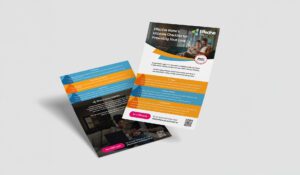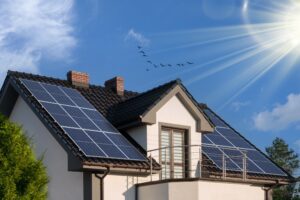What Is a Solar Inverter and What Does It Do?
A solar PV system relies on solar panels to generate electricity, but equally as vital is the solar inverter that converts the electricity generated to a usable form. Without this key component, the electricity generated by solar panels wouldn’t be able to power our homes and domestic appliances.
So what is a solar inverter and how does it work? You can find out here, along with everything else you might want to know about solar inverters.
Crucial Role of the Solar Inverter
Photovoltaic (PV) cells in solar panels release electrons when exposed to sunlight. This generates a direct current (DC) of electricity.
A direct current flows steadily in the same direction, with a constant voltage and is often used to power electronic devices. However, it’s incompatible with mains supply electrical circuits, which run on an alternating current (AC), as produced by power stations.
This is why solar panels need a solar inverter. It provides the crucial bridge to make solar power usable in our homes.
The solar inverter – also known as a photovoltaic inverter or PV inverter – converts direct current into an alternating current. The electrons keep switching between two directions and the voltage alternates between positive and negative.This is what makes it possible for solar panels to provide your home with electricity compatible with the national grid.
The efficiency and cost savings of solar panels depends on the quality of the solar inverter. The best inverters maximise the energy generated and minimise losses during the DC-AC conversion.
How Do Solar Inverters Work?
Solar panels produce electricity from the sunlight they absorb. Initially, this energy is in the form of a direct current – the wrong type of electricity for our purposes.This is where the brain of the solar energy system comes in – the solar inverter.
Solar inverters control flow of electricity with a system of transformers and transistors and these rapidly switch direction of the current back and forth. This reduces voltage and creates an alternating current capable of powering everything electrical in your home, from lighting and heating to TVs and washing machines.
Solar inverters optimise the power output of your solar panel array and help ensure it operates safely, with precision monitoring and fault detection features.
How Long Do Solar Inverters Last?
Most solar inverters don’t last as long as solar panels. They wear out faster because they have to work harder, handling high-power loads and continuously converting direct current into alternating current. Solar inverters are also more complex than solar panels, so more things can go wrong.
You can expect a solar inverter to last 10 to 15 years. This compares with the typical 25- to 30-year lifespan of solar panels.
A number of factors influence the life expectancy of a solar inverter. High-quality solar inverters installed in the right place and regularly maintained usually last the longest.
- Solar inverter quality. Solar inverters designed to high specifications with quality hardware and more durable materials take longer to lose operational efficiency.
- Location. Where the solar inverter is located plays a big part in how long it will function optimally. Solar inverters work best in a cool, shaded spot that’s well ventilated.
- Maintenance. Solar inverters last longer if they’re monitored and maintained regularly.
- Create a Tailored Quote Based On Your Circumstances
- Takes Less Than 2 Minutes
- Fixed-Online Quotes

Types of Solar Inverters
The type of inverter needed for your solar panels depends mainly on how much power you need to generate to meet your household needs.
The most common solar inverters are string inverters and microinverters. Other types include grid-tied inverters, power optimisers, and hybrid inverters.
String Inverters
String inverters – also called central inverters – are the oldest type of inverters.They’re the most widely used because they’re based on tried and tested, affordable technology that’s fairly straightforward. Only one inverter is needed per installation.
String inverters are installed inside homes or on an exterior wall, near the consumer panel or electricity meter. They connect to a string of multiple photovoltaic solar panels linked end to end. A string inverter is usually installed alongside 5 to 10 solar panels.
Pros and Cons of String Inverters
String inverters have stood the test of time as a reliable means of powering homes, with simple maintenance.
Issues with solar panel systems are often down to the inverter. When there’s just one, string inverter, troubleshooting and repair is easier, and doesn’t necessitate access to the roof.
On the downside, if a string inverter breaks down, the entire solar energy system will stop working. And a string inverter is only as efficient as the lowest-performing module in the solar array.
Microinverters
While a string inverter connects to a chain of solar panels, microinverters are linked directly to individual panels. Unlike string inverters, microinverters function in a parallel circuit and are generally used with complex solar panel installations across multiple roof surfaces.
One inverter is typically attached to each solar panel, where power conversion takes place at the source of energy production. Some microinverters, however, can work with more than one solar panel.
Pros and Cons of Microinverters
Microinverters are more efficient than string inverters. They convert the entire power output of each solar panel into alternating current.
Performance isn’t reliant on the least efficient solar panel in the system, and if one panel fails, it won’t greatly impact the system as a whole.
However, microinverters cost significantly more than string inverters and may not be suitable for simple domestic solar arrays. And if a microinverter breaks down, someone has to get up on the roof to repair it.
Grid-Tied Solar Inverters
Unlike off-grid inverters, which don’t work in conjunction with the national grid, grid-tied solar inverters link to a property’s mains power supply and switch between solar and mains electricity. When the solar panels aren’t generating sufficient power, the grid-tied inverter draws power from the mains.
Grid-tied inverters – also known as on-grid inverters – incorporate smart processing so the system knows when grid power is required.
Pros and Cons of Grid-Tied Inverters
A grid-tied inverter doesn’t need additional equipment such as a battery and it can sell electricity back to the grid as well as power homes.
But a standard grid-tied inverter isn’t entirely independent of the grid and will automatically shut down during a power cut.
Power Optimiser Inverters
Power optimiser inverters improve efficiency of solar power systems by optimising direct current electricity output of each solar panel. They send direct current electricity to a string inverter or hybrid inverter, usually located near the battery storage system.
Performance of each solar panel is monitored online to detect any problems and prevent electrical faults.
Pros and Cons of Power Optimisers
Like microinverters, power optimisers provide the benefits of panel-level optimisation and performance monitoring, and they tend to cost less. However, they’re more expensive than string inverters
Hybrid Solar Inverters
Hybrid solar inverters make the most of a solar panel system by optimising energy use and cost savings. When solar panels produce more electricity than needed, the hybrid inverter sells the excess to the national grid or stores it in a solar battery.
When the panels don’t produce enough electricity for your home, the inverter draws power from the grid or solar battery.
Pros and Cons of Hybrid Inverters
Hybrid inverters can be integrated directly into solar battery storage. This centralises monitoring of the solar array performance.
They incorporate battery backup so you still have electricity in the event of a power outage.
Hybrid inverters do cost more than string inverters. And they can only be used with DC solar batteries, which limits battery options.
- Create a Tailored Quote Based On Your Circumstances
- Takes Less Than 2 Minutes
- Fixed-Online Quotes

Solar Inverter Costs
A solar inverter is typically included in the cost and installation of a solar panel system. Solar arrays range in price from around £4,200 to £9,800, depending largely on the size of your house and type of solar panels.
Solar panels have an impressive lifespan. Solar inverters don’t last quite as long and will likely have to be replaced at some point during the lifespan of your solar panels.
The price of solar power inverters varies widely, ranging anywhere from £500 to a couple of thousand pounds.
Solar inverter costs are dictated largely by the type of inverter and its potential power output and conversion efficiency.
- A string inverter for an average home costs around £500 to £1,500.
- Microinverters cost 10 to 30% more than a string inverter, ranging from £20 to £100 for each solar panel.
- A mid-range hybrid inverter costs from £1,200 to £1,500.
- Grid-tied inverters range in price from around £400 to £950.
- Power optimisers cost around £40 a unit, increasing to around £180 for smart solar panel systems.
Financial Help to Install Solar Panels
Unlike with some green energy systems, grants are not universally available to install solar panels.
The Free Solar Panel Scheme, with grants up to £11,000, came to an end in 2019. The Green Homes Grant ended in 2021. The Renewable Heat Incentive (RHI), which cut the cost of solar panel installation by nearly £3,000, expired in 2022.
However, government grants are on offer in some circumstances. And other financial aid comes in the form of the Smart Export Guarantee, VAT reductions, and financing plans offered by solar panel installers.
Government Grants for Solar Panels
Government grants currently available to help with the cost of solar panel installation include ECO4, LA Flex, and the Home Upgrade Grant.
ECO4
ECO4 is the fourth phase of the government’s Energy Company Obligation Scheme. to ease fuel poverty and reduce carbon emissions among low-income households.
The scheme is aimed at homes with a low Energy Performance Certificate (EPC) rating. How much funding you can get depends on your home’s energy efficiency requirements.
ECO4 can cover up to 100% of the cost of solar panels, as long as they power an electric heating system, and a biomass boiler or heat pump has been ruled out. The scheme will run until March 31, 2026.
LA Flex
Local Authority Flexible Eligibility (LA Flex) – also known as ECO4 Flex – widens the scope of ECO4, with local councils setting their own funding eligibility criteria.
This makes solar panel funding available to households who may not otherwise have qualified for discounted energy efficiency upgrades.
Home Upgrade Grant
The Home Upgrade Grant (HUG) offers up to £10,000 in solar panel funding.
The scheme is open to homeowners with annual household income of £31,000 or less who live in certain postcode areas in England off the gas grid. It will run until March 2025.
Smart Export Guarantee
Households whose solar PV panels generate more electricity than they need can sell it back to the national grid under the government-backed Smart Export Guarantee (SEG).
SEG replaced the Feed-in Tariff (FiT), which closed to new applicants in March 2019. It creates a small but steady source of income as you get paid for each unit of electricity you export back to the grid.
Zero VAT
The standard rate of VAT on goods and services is 20%, but if you install solar panels, you can avoid paying any value-added tax.
VAT on solar panels supplied and installed by the same company is zero rated until March 31, 2027, when it will revert to the reduced 5% rate. Furthermore, from February 2024 you won’t pay VAT if you add a storage battery to your solar installation.
Solar Panel Financing
If you don’t qualify for a solar panel grant, you can look for installers who offer financing options. These payment plans allow you to spread the cost of your solar installation with monthly payments to suit your budget.
Interest rates and repayment periods vary among suppliers but some offer zero-interest options.
Benefits of Quality Solar Inverters
Solar inverters play a critical role in harnessing abundant free renewable energy from the sun. A quality inverter will allow you to get the full benefit of solar power, which has multiple advantages.
Inverters help solar panels cut electricity bills by up to 70%, saving households nearly £1,200 a year on average. Savings increase if you have solar battery storage, plus you can also sell excess electricity back to the grid if your solar panels generate more than you need.
As well as saving money, solar panels provide a green alternative to carbon fuels such as coal, oil, and natural gas, which drive climate change. Solar power produces no greenhouse gases and leaves a minimal carbon footprint.
Solar panels have also been shown to help sell homes faster and increase the value of property, by as much as 25% according to some estimates.
Most solar energy systems come with warranties of 20 to 25 years, and many last much longer with basic maintenance. Solar panels typically pay for themselves within 10 years or sooner.
Choosing the Right Solar Inverter
Solar inverters aren’t the first consideration that springs to mind when you’re considering going solar, but they’re a critical part of every solar panel installation.
Inverters come in a range of sizes, rated in watts, like solar panels themselves. You need a power inverter with the wattage capacity to handle all the power your solar array generates.
Effective Home has been installing solar panels with quality inverters in homes across the UK for more than 15 years. We’ll make sure your solar energy system comes with the right type of inverter to meet your home’s requirements at the most affordable cost.
Contact us to schedule a free site survey.
- Create a Tailored Quote Based On Your Circumstances
- Takes Less Than 2 Minutes
- Fixed-Online Quotes




